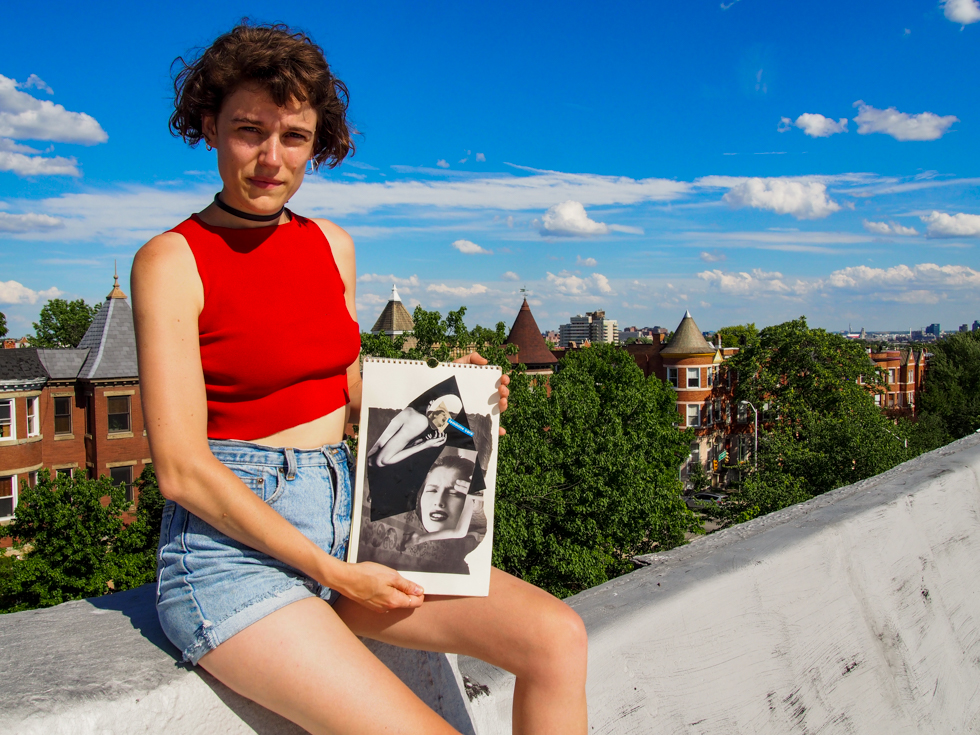
Meet Emilie Pichot: artist, activist, and traveler! Here she holds her piece “feminine care”, which according to Emilie, “was a spontaneous mess that turned into a collage and seems to have a lot to say about gendered responsibility, pain, and products.”
I am so excited to present you with the next installment of my menstruation and travel series, this time in the form of an interview! Earlier this summer I put together The Travelers’ Guide To Sustainable Menstrual Products, a guide to everything travel and menstrual products. But what’s it like to actually be out in the world, bleeding and using these products? You’re about to find out! I am honored to have gotten the chance to interview Emilie Pichot, an amazing artist, conscientious activist, and badass world traveler. Emilie has done some incredible work in menstrual activism (among many other things), and she and I sat down and talked menstruation, traveling, sustainable menstrual products, and the experience of wandering while bloody. Enjoy!
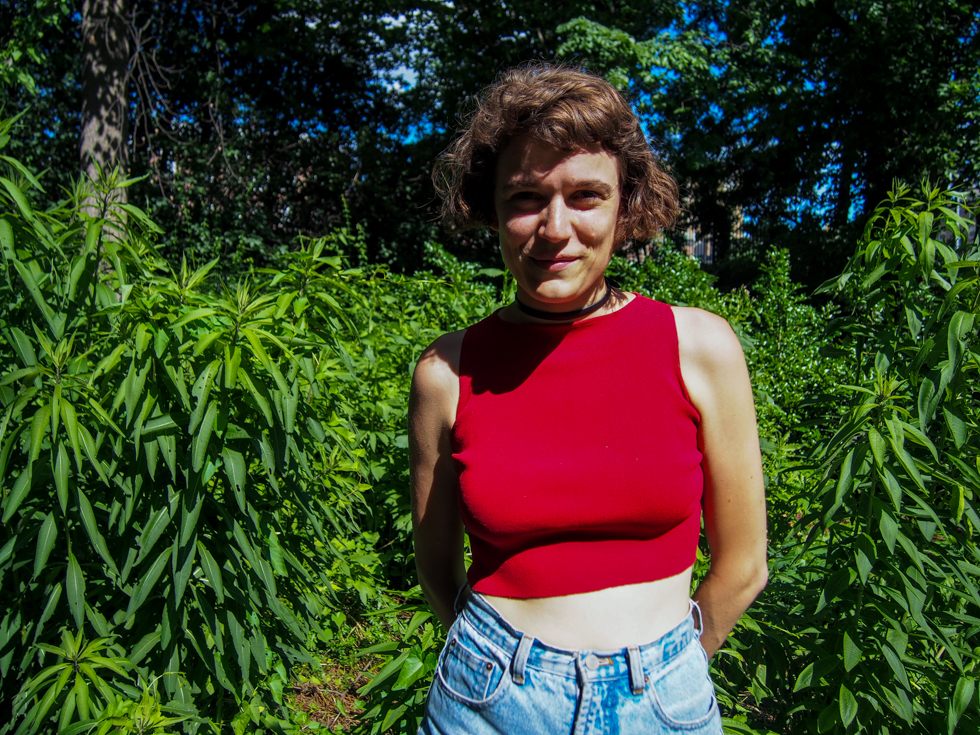
Alissa: Tell us a little bit about yourself.
Emilie: I’m currently working at the Enoch Pratt Free Library in Baltimore, Maryland at the circulation desk to determine whether I want to pursue Library Science or not. In my free time I host weekly radical horror movie nights, support people who come out of central booking/jail, read books, make collages, bake bread, and bike around the city.
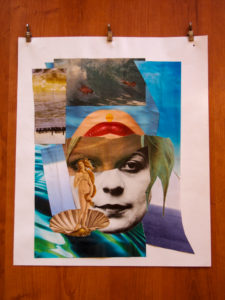
A collage by Emilie. This collage, called “advertsary”, examines the tropes and themes of advertisements for menstrual products that are common or avoided.
Alissa: You’ve done some work related to menstrual activism. What exactly is menstrual activism and why is it important? What does your menstrual activism work entail?
Emilie: Menstrual activism can entail many things. It basically involves spreading awareness about the experiences that menstruators have, as well as pushing for legislative changes or corporate changes to better support people who menstruate. Menstrual activism can include a trans or gender-nonconforming person sharing their experiences of menstruation, and thereby challenging the notion that only cis women menstruate or that only people who are assigned female at birth experience period symptoms. Another example of menstrual activism could include someone free bleeding in public.
I did most of my menstrual activism during my senior year of college. It was a multi-faceted approach that included an independent study of menstrual product advertisements, the creation of collages, and leaving free pads and tampons in public restrooms to raise awareness and as an act of kindness. I was also awarded a social justice grant, which paid for approximately 200 diva cups to offer to students for free.
Alissa: Talk to me about your travels. Where have you been? What has been your favorite place?
Emilie: I grew up very privileged to travel to France every summer, since my family is French. Also, my stepmother’s family has a reunion in a different place each year, so I got to visit lots of places, mainly in Europe. I’ve also been to Puerto Rico, Mexico, Morocco, and Turkey. It’s difficult to choose a favorite place, but I would have to say visiting Morocco was very important and interesting for me. My father’s side of the family is from a line of “pied noirs”, who are French colonizers in North Africa. My grandfather grew up in Morocco, as well as Tunisia and other North African countries, and brought parts of the culture to our family. Because of this, I felt a tie to the region and culture, and it was certainly a bonus to be able to speak to locals in French, even though that is only possible because of colonization. It’s a complicated and difficult history and feeling, but one that is unique for sure.
Alissa: What did you observe about global perceptions towards menstruation in the countries that you have visited?
Emilie: It’s definitely a taboo topic and not easily discussed. One thing I distinctly remember is in England there were these little baggies in public restrooms with a “lady” on it, and the word “dainty”, I believe. The bags were meant for “discreet” disposal of used menstrual products. It definitely made you feel how gendered menstruation is, as well as how unhygienic it is considered. This was also communicated through the separate disposal bin that would often be next to the toilet that was exclusively for menstrual product waste, making it seem like used menstrual products are somehow toxic waste because they came into contact with menstrual blood. It’s something that is considered embarrassing in a lot of places. More recently, however, I’ve noticed some public restrooms in Europe and in North America are starting to have more menstrual products for free and available for use as people are becoming more aware.
Growing up, I had a lot of friends from abroad in my high school, and I remember being surprised by how many had never tried a tampon for fear of losing it inside of themselves or breaking their hymen. It was a myth that never was dispelled and was certainly fueled by how religious our school was, in addition to living in a misogynist and patriarchal society that views menstruation as a taboo.
Finally, I haven’t been to India, but when I went to the 2015 Menstrual Health and Reproductive Justice conference in Boston, I had the honor of attending a talk by Sinu Joseph of the organization Mythri Speaks. Mythri Speaks is an educational and advocacy group based in India. During the conference, Joseph articulated how frustrating it is that many Western organizations are coming to India bringing disposable products because they hear about girls missing school due to their periods. It’s incredibly ironic because countries like India have been using reusable products for centuries, when reusable products have only recently made it into the mainstream in the U.S. The attitudes of these organizations are very neo-colonial and neo-imperialistic, making assumptions that they can “save” Indian menstruators or know what’s best for them. Some of the practices that are deemed misogynistic by the west, for example, like isolating yourself when menstruating, could be seen as anti-capitalistic and healthy, and therefore radically feminist.
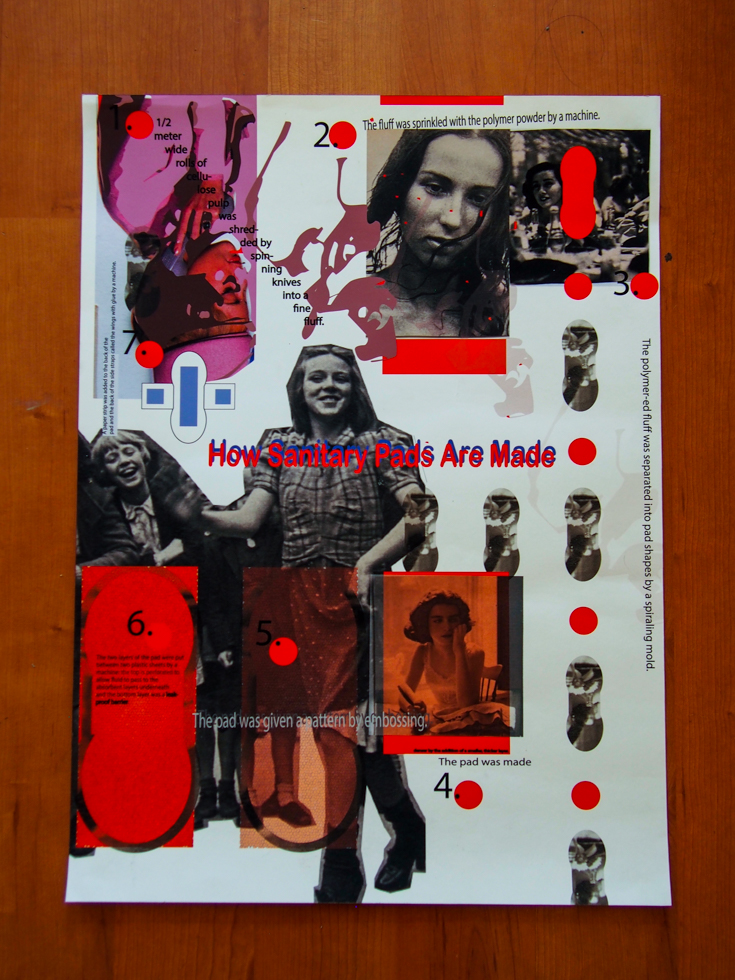
Emilie: “how sanitary pads are made” is an exploration of mass production, the co-option of menstruator liberation as a way to make a profit and have a more robotic work force, by going through the steps involved in mass producing a sanitary pad.
Alissa: What has been your experience using sustainable menstrual products while traveling?
Emilie: It’s been good! I feel like I need to say that confidently because there are a lot of folks who are tentative about using reusable items, especially when traveling and when in public restrooms. It certainly takes some getting used to and might take some more creativity, planning, and organizing yourself but you save money, are being eco-friendly, less harmful to your body, and also get to learn about your cycle more easily. I do still get anxious at times about hang drying my Lunapads (reusable pads) where cis men can see them, but every time I get nervous I try to remind myself that there’s nothing to be embarrassed about and that it’s a learning experience for them as well. I want it to become normalized.
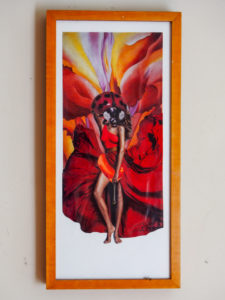
Emilie: “pests” uses leakiness as a metaphor for the way anything deemed by society as unnecessary, “too much”, a bother, a burden, or dirty, as pests, or something to be exterminated or extinguished.
Alissa: What is your favorite sustainable menstrual product? What would you recommend to other traveling menstruators?
Emilie: Definitely my menstrual cup. I specifically use a Diva Cup. I have an IUD now so my periods are lighter, but it’s still useful. The cup is easy to clean, it shows me how much I bleed, doesn’t chafe in any way, and I forget about it once it’s inside me. I can also swim with my Diva Cup! Before I got the IUD I used reusable pads in addition to my menstrual cup, but now I don’t have to wear pads at all, which is kind of better in the summer since sometimes wearing a cloth pad isn’t always fun when it’s 90+ degrees out.
Just as an aside, I also have THINX underwear and don’t really recommend it. When I tried using it by itself when I had my regular period without an IUD it became very uncomfortable. It also somehow always manages to smell bad, unlike other products I use. Besides being the sexy lacy high-waisted underwear that it is, I wouldn’t recommend it. I’m also wary of how popular and “high-tech” reusable products are becoming when old-fashioned cotton products have been working great for a very long time. Capitalism is gonna be handing us several startups and supposedly “radical” new companies, but that won’t always be what we really need or necessarily is that revolutionary. Especially when these companies don’t treat their employees well (who happen to be mostly women); you can read more about this in this article.
Alissa: Do you have any anecdotes about traveling and menstruation?
Emilie: I’ll just share with you my routine and what I took me with on a recent trip to Europe for a week to see family and friends. I travel with my Diva Cup, two reusable pads just in case, Tension Tamer Tea (though any tea with raspberry leaf in it should do) for cramps, and some Tylenol in case the cramps get bad.
As my period approaches, I start carrying a pad and the cup with me everywhere I go so that I’m prepared once I get my cycle, but now that I have the IUD it’s less urgent. I wear my cup the whole time, and if it’s a heavy cycle I try to empty it every time I use the toilet and I rinse the cup with water. Once my cycle is finished I soak it overnight it hot water and soap after cleaning it, or I put it in boiling water for 10 minutes on the stovetop. With the pads, I change them once they start to smell and/or feel uncomfortable. I wring them under cold water until I no longer see any blood running and then throw them in my laundry bag. I’ve never had any stains in my clothes from cleaning everything together. Obviously you may want to be careful about washing it with pure whites, but besides that it should be fine. Another detail about my pads is that I got black ones online. The colorful ones will only be colorful and pretty for a little while and then you’ll have a dark brown stain on it…if you’re into that, go for it! In fact, the blood over time even stains my black ones…how badass is that?
One thing I want to emphasize is try to be proud of yourself and less hard on yourself. For me, that means seeing the shame I feel around a stain, a leak, a long wait in the line at the public restroom, as the result of a society that isn’t designed for menstruators. This is similar to the shame I feel about being vulnerable by asking someone out, expressing my opinion in a large room of people and not sounding as articulate as I would like, or desiring someone deeply, because it is also a society that hates softness, atypical expression, and slowness. Being less hard on myself is something I personally struggle with in this society that depends on people to be machines and not leak anything at all, whether that is an emotion, personal experiences, speaking truth to power, or a bodily fluid!
Something that I find fun to do that helps me feel great about my body and can even be an act of secret revenge, is to use menstrual blood in painting. It helps me reconfigure in my mind that my body doesn’t only produce waste, but also creativity.

Yes, those are paintings made with menstrual blood. According to Emilie: “sketches with blood and study for ‘how sanitary pads are made'” is the result of fooling around coupled with an attempt at visually analyzing the sanitary pad.
Alissa: What plans do you have for the future regarding travel? Regarding activism?
Emilie: With my job commitments, I can’t travel as much anymore, unfortunately. However, once I quit my job I intend on taking a gap year that includes traveling within the U.S., Latin America, and Canada, and then spending possibly another year doing WOOFing and work-away in France.
In terms of activism, I’m trying to see how much more I can push myself, challenge myself, and bring risk into my life. I feel like that is what needs to be done, especially as a privileged, able-bodied, white, cis person. That means not calling the cops, perhaps risking job opportunities and losing jobs, etc. If you’re unfamiliar with why you shouldn’t call the cops, reflect on how much violence you see them perpetuate in the news. Freddie Gray, Rakia Boyd, Eric Garner, and Trayvon Martin are just a few cases of racist police violence against black people, and the list goes on. For more information, see this article on the history of policing, and check this zine out.
After doing this interview, I’ve been inspired to ensure we have a stock of menstrual products to offer folks coming out of jail during jail support. Every week, I join several other activists in providing free rides, phone calls, water, snacks, cigarettes, and coffee to folks being released from jail. I know we have a small pack of menstrual products but now I’ll have it on my radar to make sure it’s replenished.
Alissa: Are there any resources that you recommend for folks interested in learning more about menstrual activism?
Emilie: I would recommend the following:
- Threads Zine
- “Becoming a leak” by Emma Pask
- Mythri Speaks
- Chella Quint
- Margrit Shildrick’s Leaky Bodies and Boundaries: feminism, postmodernism, and (bio)ethics
- Elizabeth Kissling’s Capitalizing on the Curse: The Business of Menstruation
- Sharra Vastral’s Under Wraps: A History of Menstrual Hygiene Technology
- Society For Menstrual Cycle Research resource page
- “There Will Be Blood” image gallery
- The online Museum of Menstruation and Women’s Health
Alissa: Where can people follow you?
Emilie: Visit my blog to see all the work I did my senior year: https://freefromfemininehygiene.wordpress.com/
I am also the co-editor of Little Deaths Zine, available for purchase in some bookstores in Baltimore and the Bay Area. Follow us on Facebook!
For unrelated things, people can follow me on Instagram @irl_url_irl_url_irl_url or on tumblr at slowcirculation.tumblr.com.
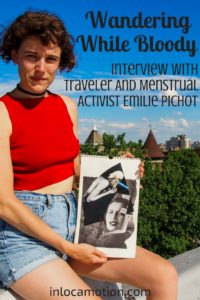









6 comments
Love this!
I’m so glad you do!!! Thanks for reading and commenting 🙂
This is an extremely important topic that needs attention and thank you for bringing it strongly within the travel blogging community. Love all of the Q&A. More power to Emilie and you 🙂
Aw, I’m so glad that you liked it! Thank you for reading and for your positive feedback, Ketki!
When I read this, all I can think of is go girl! We need to address more issues such as this for travels and day to day too. I liked Emilie’s answers. She is clearly a strong woman who has one goal: to raise awareness and make us all understand there is nothing wrong with the normality of being a woman. I am more reserved in this respect, but most certainly I appreciate Emilie’s views on the matter!
I agree, Emilie is a super strong person with so many important things to say – which is exactly why I wanted to showcase her perspective in this interview!! I would just expand that Emilie is working to normalize menstruation/bleeding/leaking in general, regardless of who bleeds: women, men, GNC folks, trans folks etc. I’m also curious about what you mean when you say “I am more reserved in this respect”? Does this refer to being vocal about menstruation in general? Anyway, thank you for reading and commenting, Cory! Glad you enjoyed the interview 🙂